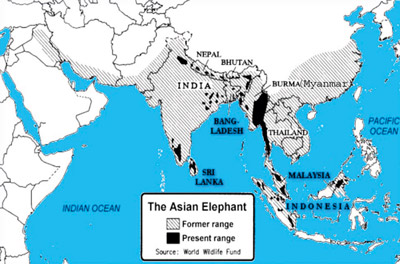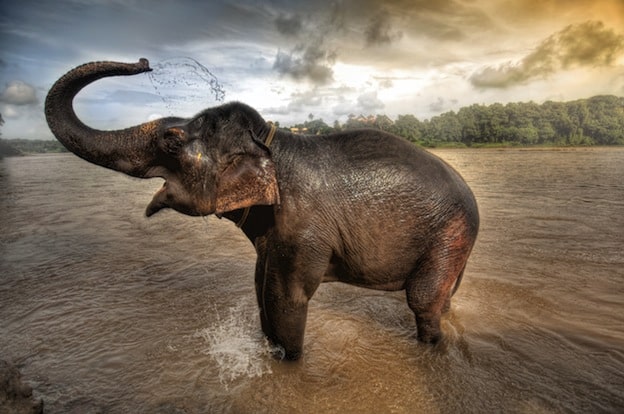|
|
Post by Ceratodromeus on Feb 14, 2017 8:02:10 GMT 5
 Scientific classification Scientific classification
Kingdom: Animalia Phylum: Chordata Subphylum: Vertebrata Class: Mammalia Order: Proboscidae Family: Elephantidae Genus: Elephas Species: E.maximumsRecognized subspecies- Indian elephant - E.m.indicus
- Sumatran elephant - E.m.sumatranus
- Sri Lanka elephant - E.m.maximus
Geographic distribution
Asian elephants inhabit grasslands, tropical evergreen forests, semi-evergreen forests, moist deciduous forests, dry deciduous forests and dry thorn forests, in addition to cultivated and secondary forests and scrublands. Over this range of habitat types elephants occur from sea level to over 3,000 m (9,800 ft). In the Eastern Himalaya in northeast India, they regularly move up above 3,000 m (9,800 ft) in summer at a few sites. In China, Asian elephants survive only in the prefectures of Xishuangbanna, Simao, and Lincang of southern Yunnan. In Bangladesh, some isolated populations survive in the south east Chittagong Hills.A herd of 20-25 wild elephants was reported as being present in the Garo Hills of Mymensingh in the late 1990s, being detached from a big herd in the Peack hills of India and prevented from returning by fences put up in the meantime by the Indian border security force. The herd was estimated at about 60 individuals in 2014.  Biology BiologyIn general, the Asian elephant is smaller than the African elephant and has the highest body point on the head. The back is convex or level. The ears are small with dorsal borders folded laterally. It has up to 20 pairs of ribs and 34 caudal vertebrae. The feet have more nail-like structures than those of African elephants—five on each forefoot, and four on each hind foot. Average shoulder height of females is 2.4 m (7.9 ft), and average weight is 2.7 t (3.0 short tons), while average shoulder height of males is 2.75 m (9.0 ft), and average weight is 4 t (4.4 short tons). Length of body and head including trunk is 5.5–6.5 m (18–21 ft) with the tail being 1.2–1.5 m (3.9–4.9 ft) long. The largest bull elephant ever recorded was shot by the Maharajah of Susang in the Garo Hills of Assam, India in 1924, it weighed 7 tonnes (7.7 short tons), stood 3.43 m (11.3 ft) tall at the shoulder and was 8.06 m (26.4 ft) long from head to tail. There are reports of larger individuals as tall as 3.7 m (12 ft).  Elephants are crepuscular. They are classified as megaherbivores and consume up to 150 kg (330 lb) of plant matter per day. They are generalist feeders, and both grazers and browsers, and were recorded to feed on 112 different plant species, most commonly of the order Malvales, and the legume, palm, sedge and true grass families. They browse more in the dry season with bark constituting a major part of their diet in the cool part of that season. They drink at least once a day and are never far from a permanent source of fresh water. They need 80–200 litres of water a day and use even more for bathing. At times, they scrape the soil for clay or minerals. Adult females and calves may move about together as groups, but adult males disperse from their mothers upon reaching adolescence. Bull elephants may be solitary or form temporary 'bachelor groups'. Cow-calf unit sizes generally tend to be small, typically consisting of three adult females which are most likely related, and their offspring; however, larger groups containing as many as 15 adult females may occur. There can also be seasonal aggregations containing 100 individuals at a time, including calves and subadults. Until recently, Asian elephants, like African elephants, were thought to typically follow the leadership of older adult females, or matriarchs, but females can form extensive and very fluid social networks, with individual variation in the degree of gregariousness. Social ties generally tend to be weaker than in African elephants. Elephants are able to distinguish low amplitude sounds. They use infrasound to communicate; this was first noted by the Indian naturalist Krishnan and later studied by Payne. musth". This is a period where the testosterone level is up to 100 times greater than nonmusth periods, and they become extremely aggressive. Secretions containing pheromones occur during this period, from the paired temporal glands located on the head between the lateral edge of the eye and the base of the ear. The gestation period is 18–22 months, and the female gives birth to one calf, only occasionally twins. The calf is fully developed by the 19th month, but stays in the womb to grow so that it can reach its mother to feed. At birth, the calf weighs about 100 kg (220 lb), and is suckled for up to three years. Once a female gives birth, she usually does not breed again until the first calf is weaned, resulting in a 4- to 5-year birth interval. Females stay on with the herd, but mature males are chased away.  Asiatic elephants reach adulthood at 17 years of age in both sexes. Elephants' life expectancy has been exaggerated in the past; they live on average for 60 years in the wild and 80 in captivity
en.wikipedia.org/wiki/Asian_elephant |
|
|
|
Post by Ceratodromeus on Feb 14, 2017 8:51:03 GMT 5
Sad news... Packy, Oldest Male Elephant in North America, Dies at 54
 "Packy, the oldest male of his species in North America, died in captivity at the Oregon Zoo on Thursday. He was 54. The elephant was euthanized after suffering from a drug-resistant strain of tuberculosis and after veterinarians failed to find an alternative method to treat it, according to the Associated Press. In a statement obtained by NBC News, the lead veterinarian for the Oregon Zoo, Dr. Tim Storms, said, “We’d run out of options for treating him. The remaining treatments involved side effects that would have been very hard on Packy with no guarantee of success, plus a risk of creating further resistance.” “None of us felt it would be right to do that,” Storms continued. “But without treatment, his TB would have continued to get worse.” Packy drew international attention when he was born in 1962 for being the first elephant born in the Western Hemisphere in 44 years. More than 1 million people visited the zoo in Portland, Oregon that year, the AP reports. He was featured in an 11-page spread in Life magazine the year he was born, and there were Rose Parade floats were created in his honor. According to the AP, from Packy’s birth to the birth of his daughter, Shine, in 1982, Portland saw the birth of 21 of the 27 Asian elephants born in North America. “Packy’s birth started it all,” elephant curator Bob Lee said. “The focus on elephant welfare, the knowledge about elephants. If you think about the time when he was born, it’s mind-boggling — Kennedy was president, the Beatles hadn’t made any records yet, cigarettes didn’t have warnings from the Surgeon General. We’ve learned so much about elephants since then, and it never could have happened without Packy.” The Oregon Zoo wrote on their website that a memorial event for Packy will be announced when plans are finalized. People can offer condolences or post their favorite memories of him on their Facebook page." people.com/pets/elephant-packy-dies-at-54/ |
|
|
|
Post by Infinity Blade on Mar 9, 2020 18:51:42 GMT 5
|
|
|
|
Post by TigreFeroce9 on Mar 21, 2020 15:21:43 GMT 5
A tusk-less future for the Asian elephant

Picture the Asian elephant without its elegant tusks. Ecological scientists filming the pachyderms for months together at the Kaziranga National Park in the north-east Indian state of Assam say this picture might become a reality in a few thousand years from now. The reasons, they figure, are two-fold. One, tusks are merely ornamental, not of much use to the animal and thus dispensable. And two, poaching pressures are rendering more and more elephants toothless.
Analysing over 450 hours of video footage of Asian elephants, Karpagam Chelliah and Raman Sukumar from the Centre for Ecological Sciences at the Indian Institute of Science, Bangalore, conclude that the magnificent beasts might adapt and evolve into becoming tusk-less creatures in times to come .
The duo set out to study the most important factors that determine the winner in a duel between two male elephants. They considered parameters such as body size, tusk and 'musth' (an annual period of heightened aggressiveness and sexual activity in male elephants).
Elephant tusks are elongated upper incisor teeth. In Asian elephants (Elephas maximus), females do not have tusks. Among males, some have tusks and some don't (called makhnas). The number of makhnas vary between populations, from just five per hundred in some to more than 95 per hundred in others. Over three years (2008-2011), the researchers spent 458 days in Kaziranga video-taping and documenting elephant behavior. They then isolated 116 instances where males interacted, and sometimes sparred, with each other.
When they examined who won these jousts, the results were categorical. Musth males always won tussles. The second most important factor for a winning male was his size, just like in African elephants. They found that whether a male had tusks or not was least important.
Out of 86 interactions between males, musth ones won an incredible 84 times (a 98% success rate). On the other hand, out of 82 times when one male had a tusk advantage, the tusker won only 54 times (a 66% success rate). Tuskers lost to both musth males and larger males.
The tensile strength of the Asian elephant tusk is surprisingly low — some species of bamboo have double the tensile strength of such ivory. Elephants can easily snap bamboo with their trunk and body weight, and it is possible they can do the same with an opponent's tusks. "I have seen makhnas grab the tusks of a tusker and push," says Chelliah.
The status of tusks, was therefore, found to be "at the bottom of the hierarchy of male-male signals" and thus could facilitate rapid evolution of tuskless males in the population under artificial selection against tusked elephants increasingly poached for ivory. It may so happen that tusked males are entirely wiped out from the region and replaced with makhnas, the researchers say.
"It would be interesting to examine whether the high proportion of tuskless adult male elephants in northeastern India is a consequence of artificial selection imposed upon a system of signals in male-male combat in which musth and body size override the advantage of possessing tusks," the authors write in their paper.
www.natureasia.com/en/nindia/article/10.1038/nindia.2013.140
|
|
|
|
Post by Infinity Blade on Apr 15, 2023 5:54:21 GMT 5
|
|











